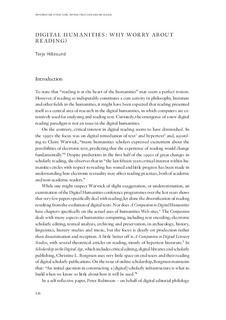| dc.description.abstract | In this study, interviews reveal that sustained discontinuous reading constitutes a distinctive
reading characteristic among humanist scholars. Preferring paper to screen, scholars
actively use their hands in flicking, jumping, underlining and annotating when studying
long-form academic and literary texts. The study has been carried out against a background
of complaints amongst digital humanities scholars on the rather moderate use of digital
resources and a general neglect on the part of the broader humanities community, a
situation which some researchers argue can only be improved by designing tools that
resemble the ordinary study habits of humanist scholars.
In the digital humanities, critical interest in reading seems to have waned, and some
scholars are now calling for more user-oriented basic research. Outside the digital
humanities, however, research on reading is immense, and a brief review confirms that a
great deal of knowledge has been acquired, much of which is highly relevant for the digital
humanities. The review also reveals a new interest in reading technologies and a realisation
that reading – in addition to mental processes – involves basic corporal and motility
aspects. Materiality, it is said, heavily influences the way we handle and interpret text, and
features of digital text will require new ways of reading, new intellectual techniques, and
new relationships to the written word.
Focusing on physical aspects, the study examines continuousness in academic reading, text
immersion, multimodality, hypertext, and the use of body, hands and fingers, while at the
same time comparing paper and screen reading. The study describes how participants use
the Web for searching and accessing literature, whereas sustained reflective reading is done
on paper and dominated by unfaithful and discontinuous reading characterised by manual
handling, underlining and writing. Being ill-suited for prolonged reading, the study suggests
that digital humanist projects use Web browsers for overviews and access, and otherwise
for delivering analytic and study tools in a layered sandwich structure. When sustained
reading is required, preceding or entwined in analytic tasks, dedicated reading software
ought to play a major role, along with compounds of text prepared for handheld reading
devices. This, it is argued, will bring texts from the cultural heritage into the digital domain
in a fashion compatible with working habits of humanist scholars, thus preserving
significant links to the very long tradition of written discourse in literature, philosophy and
science. | en_US |
